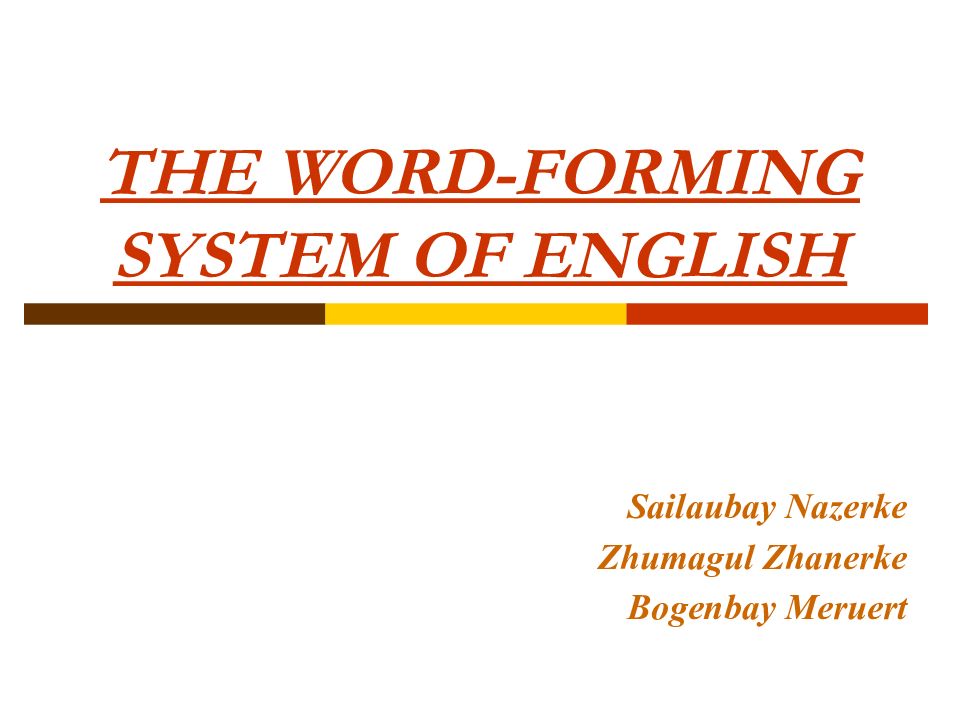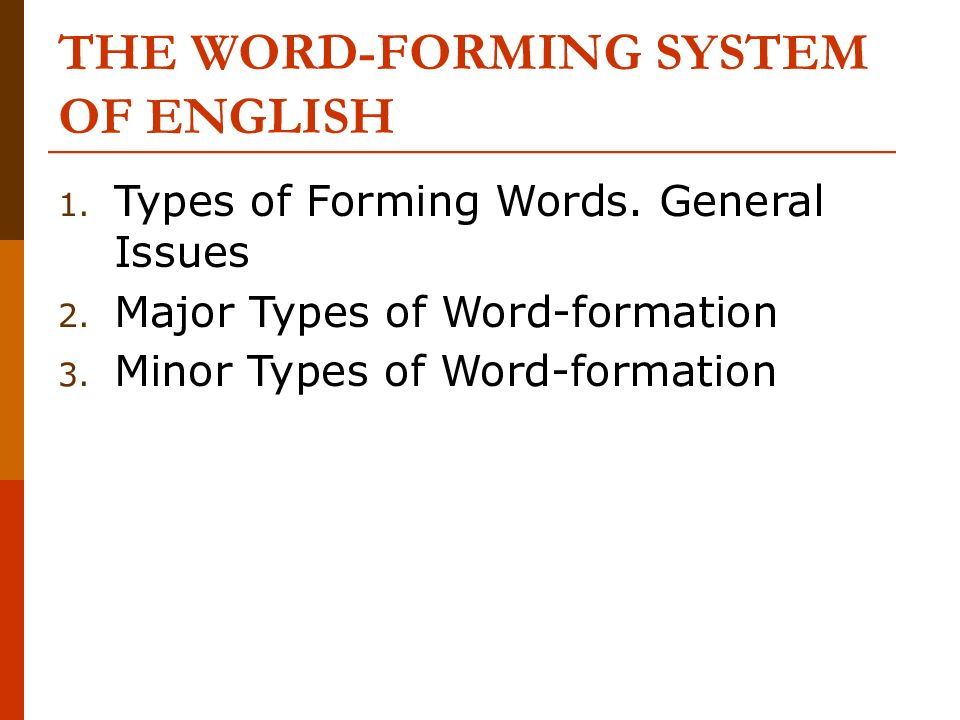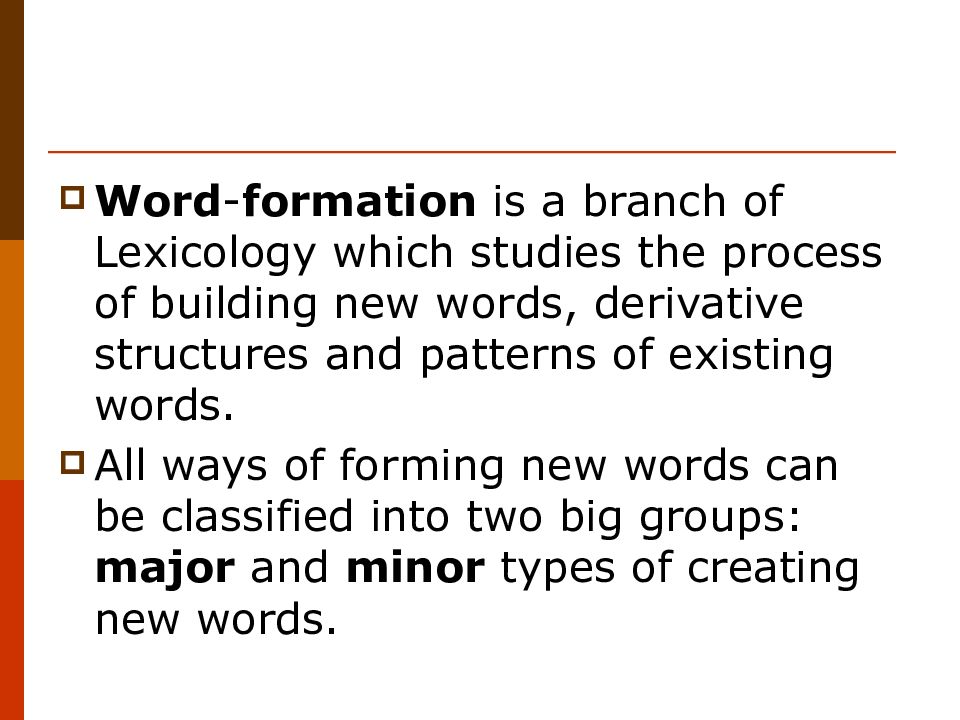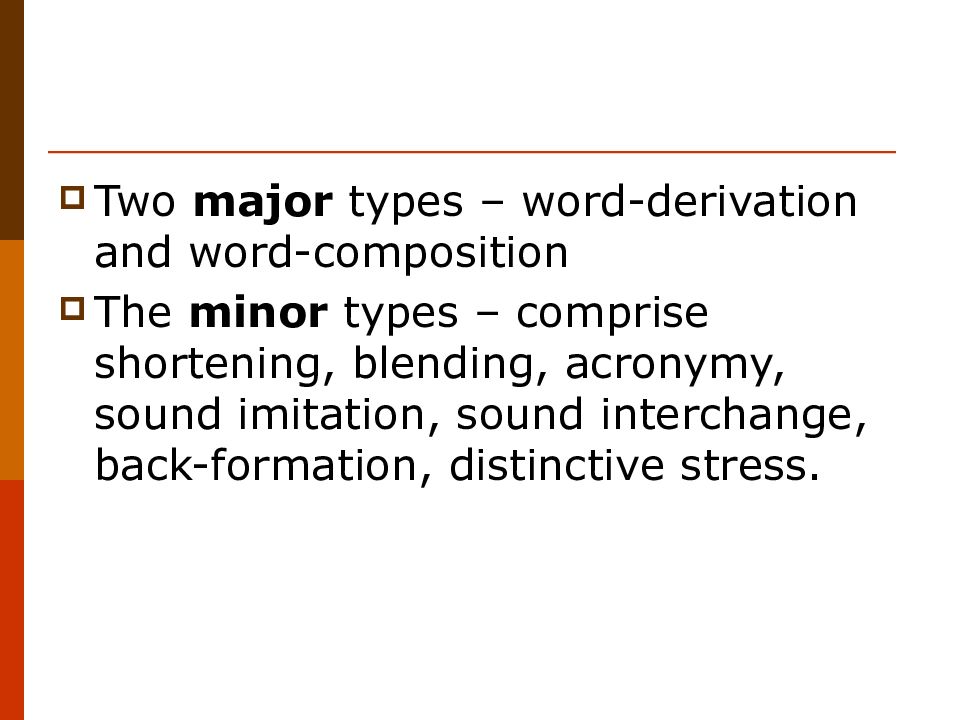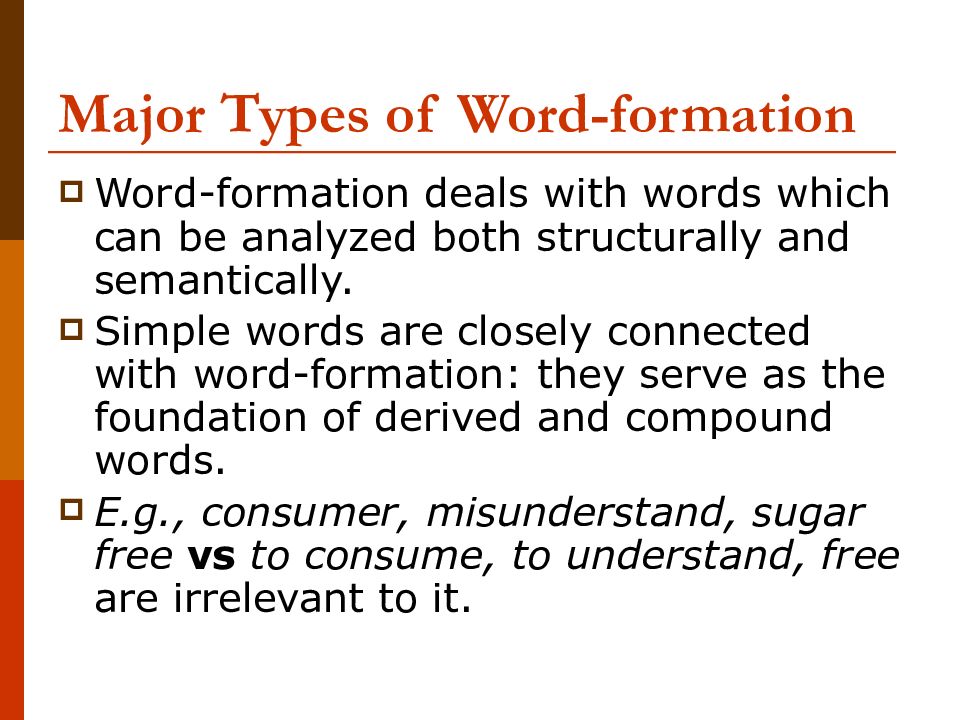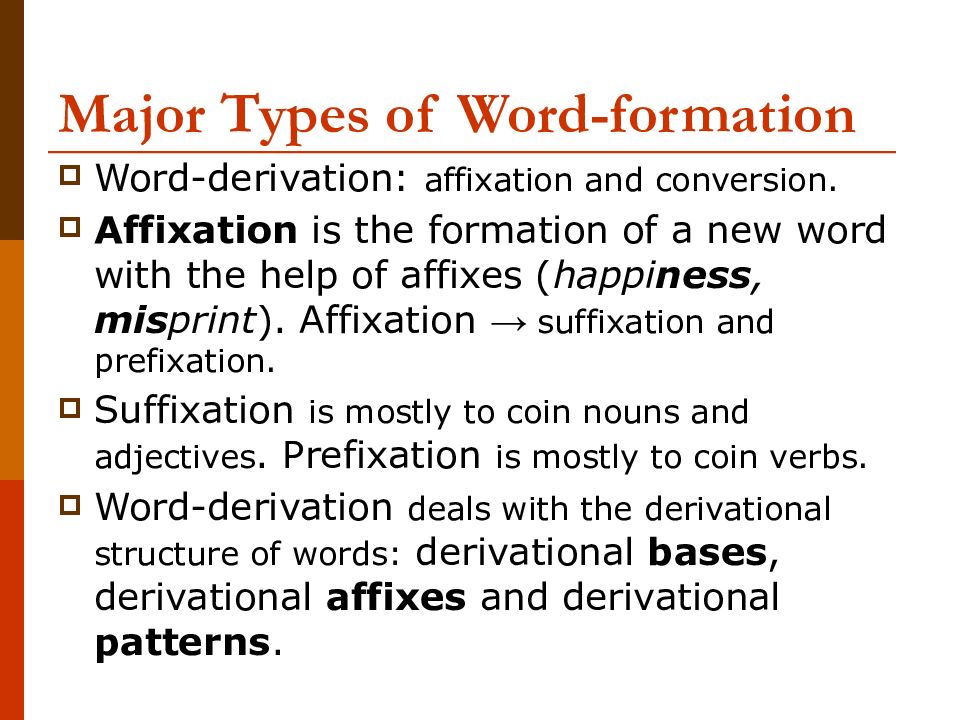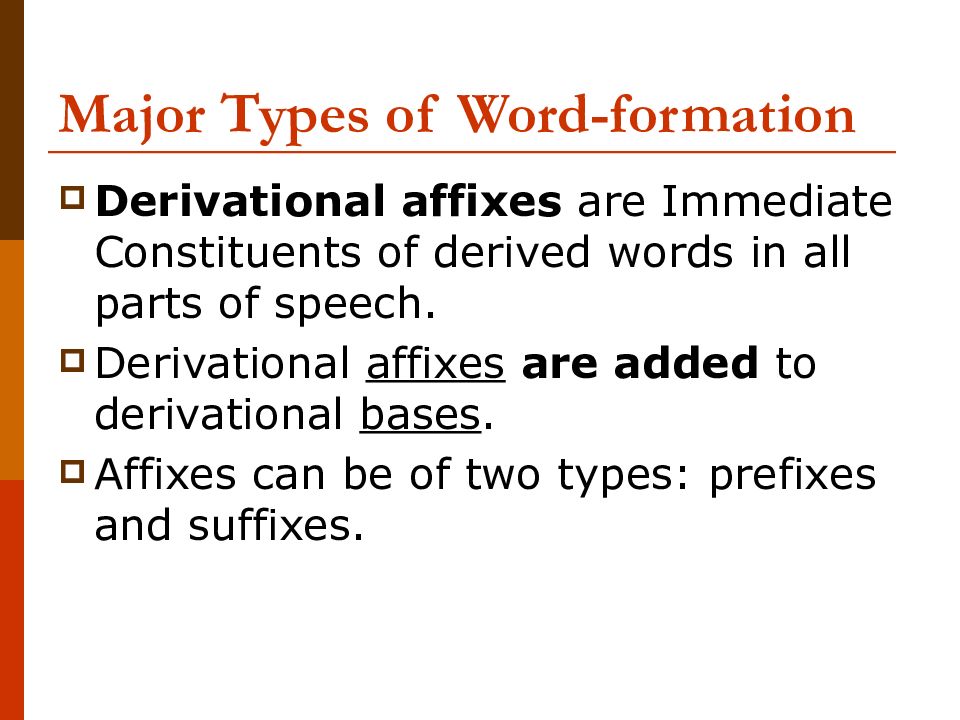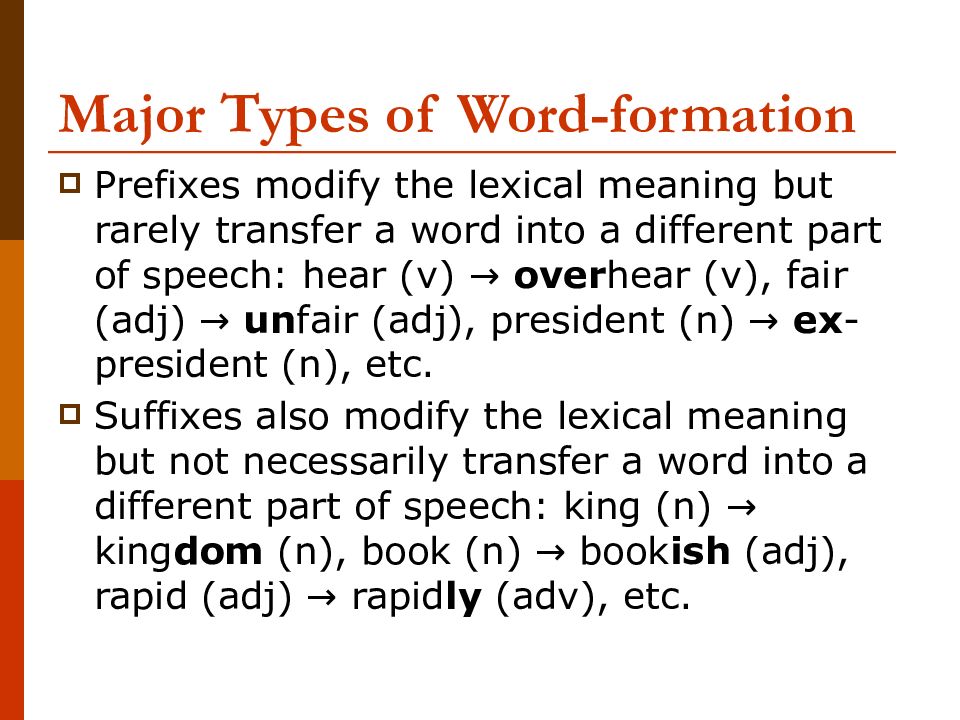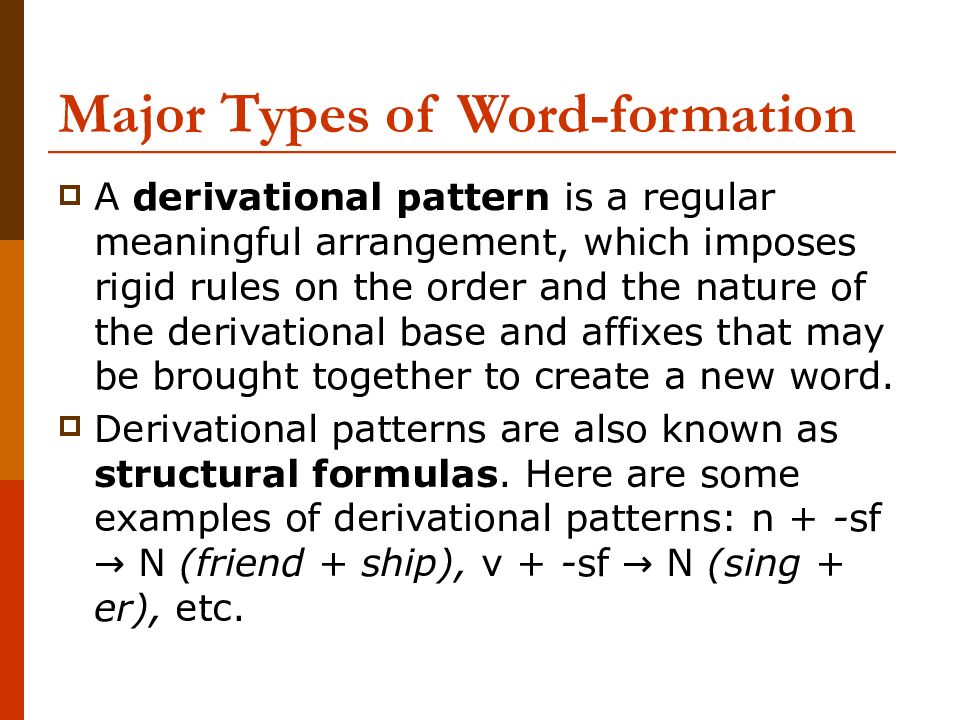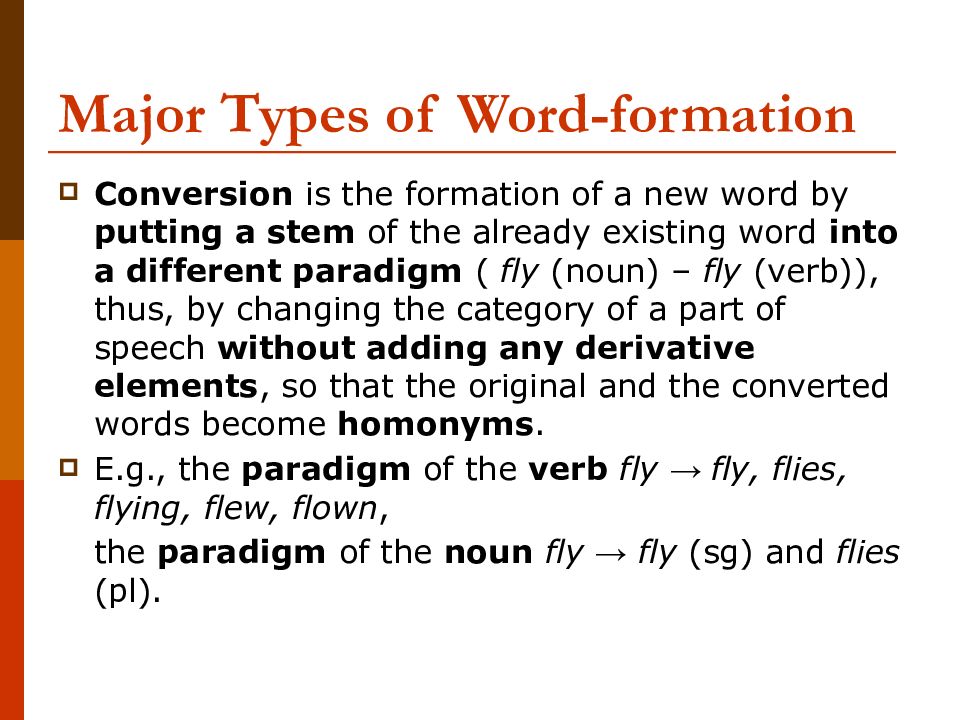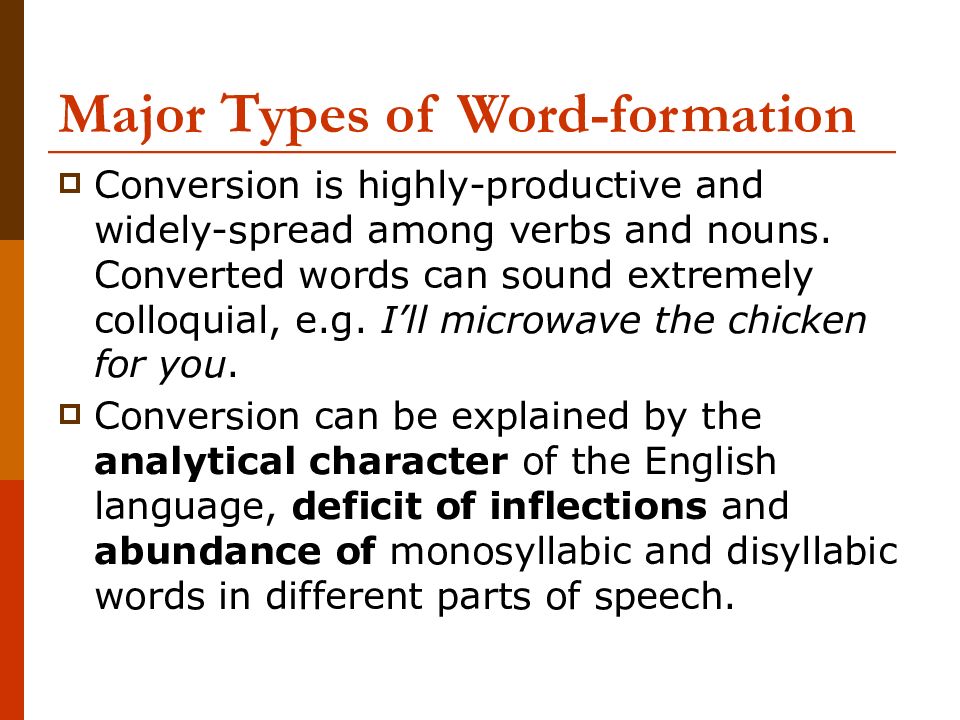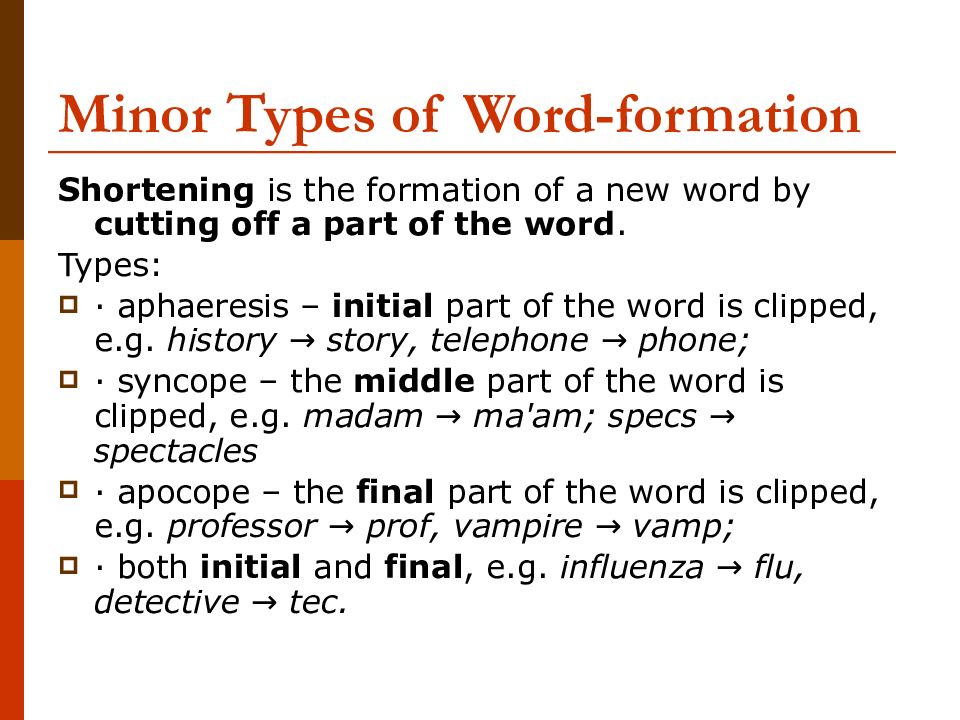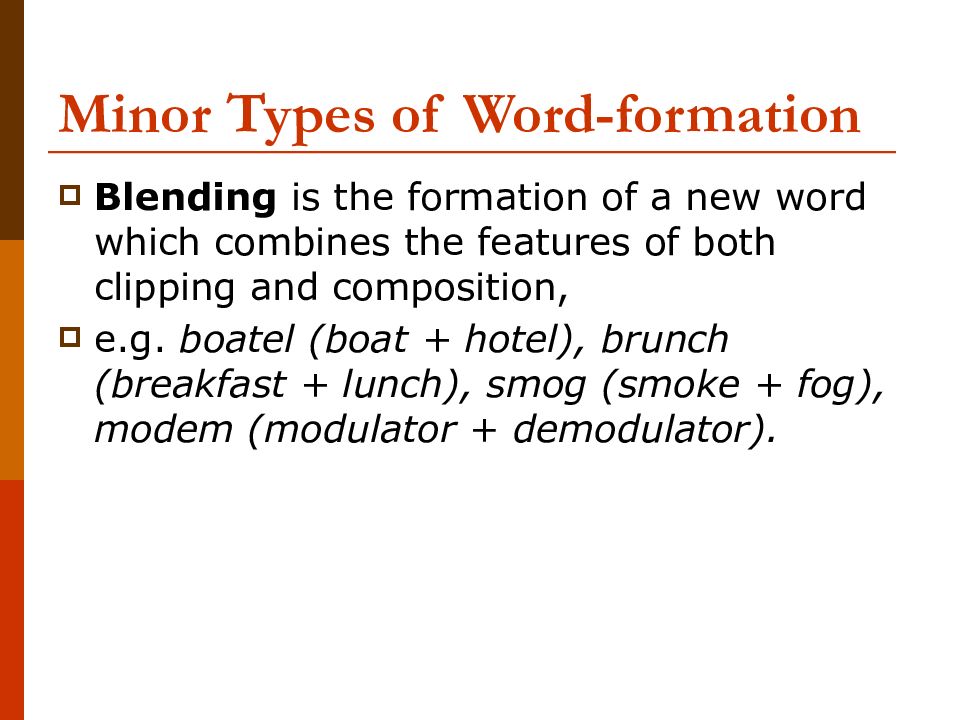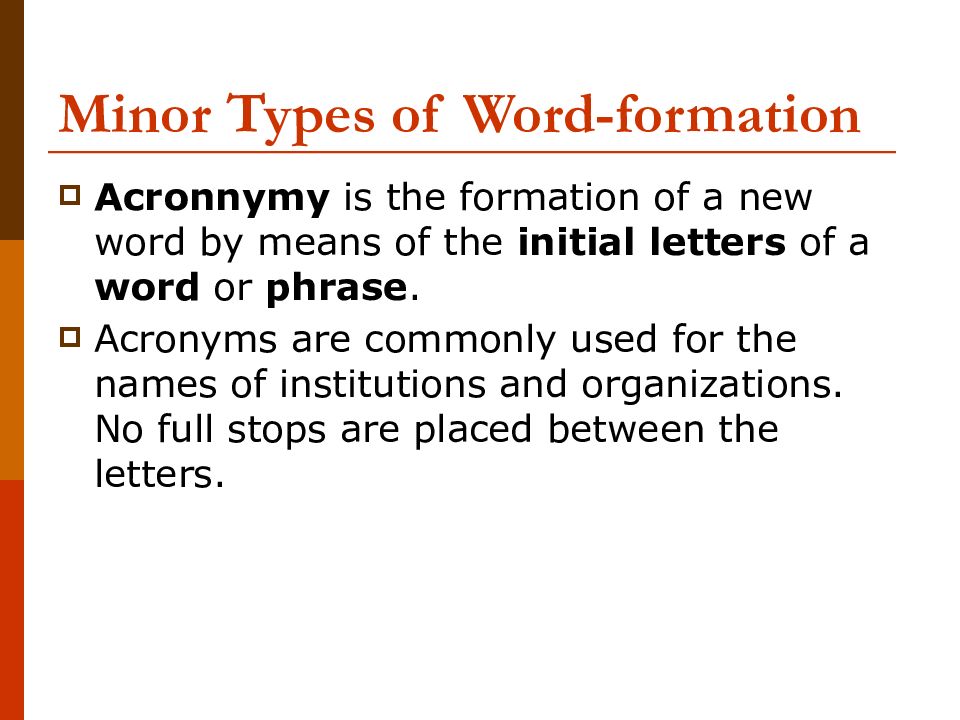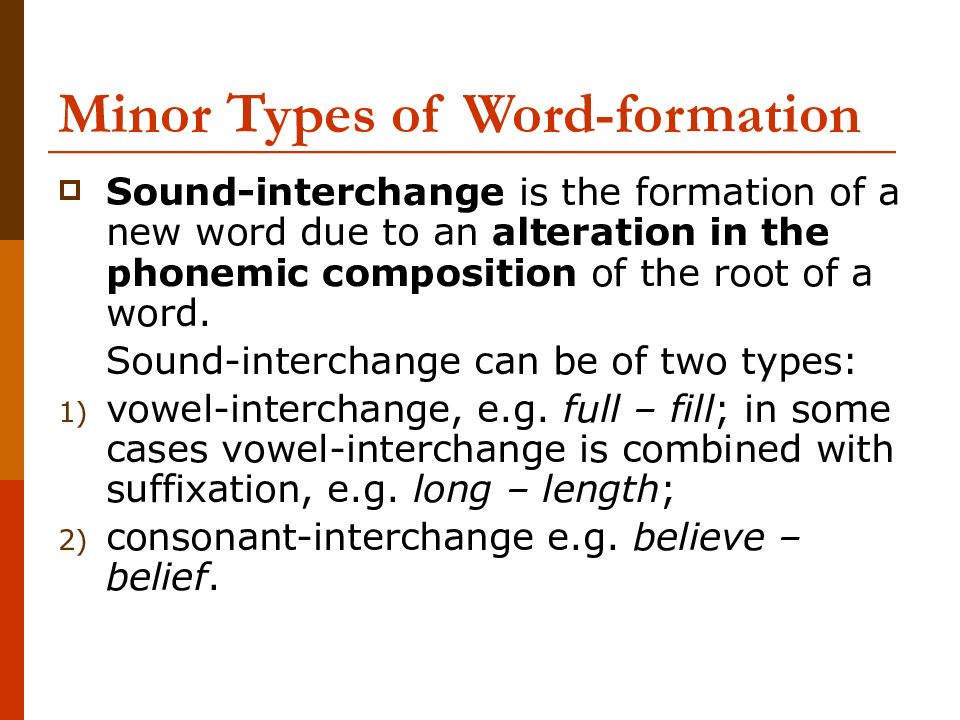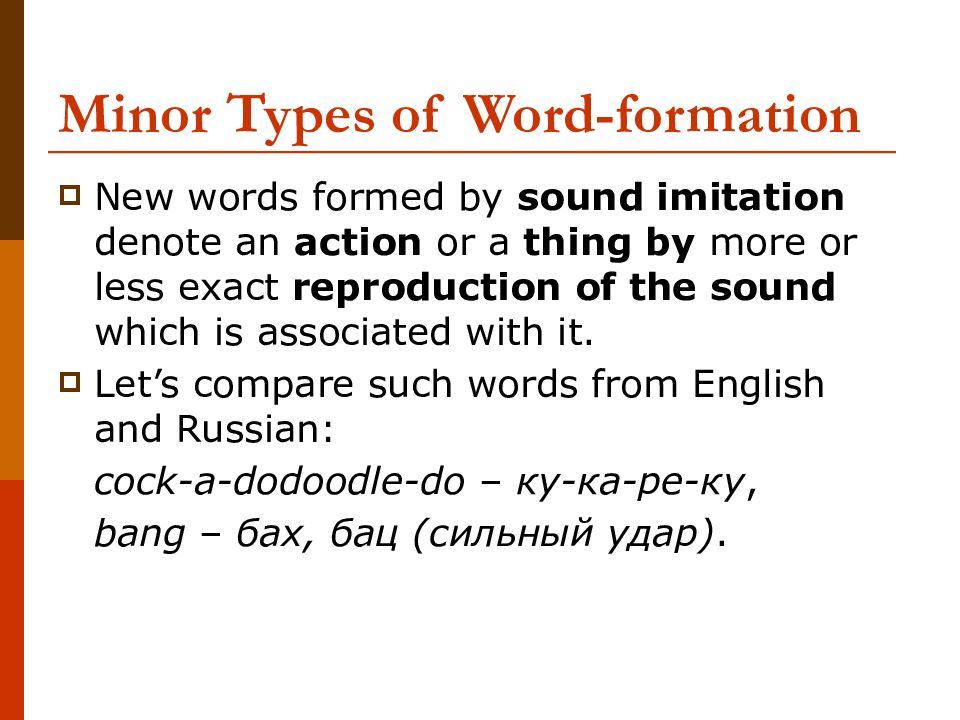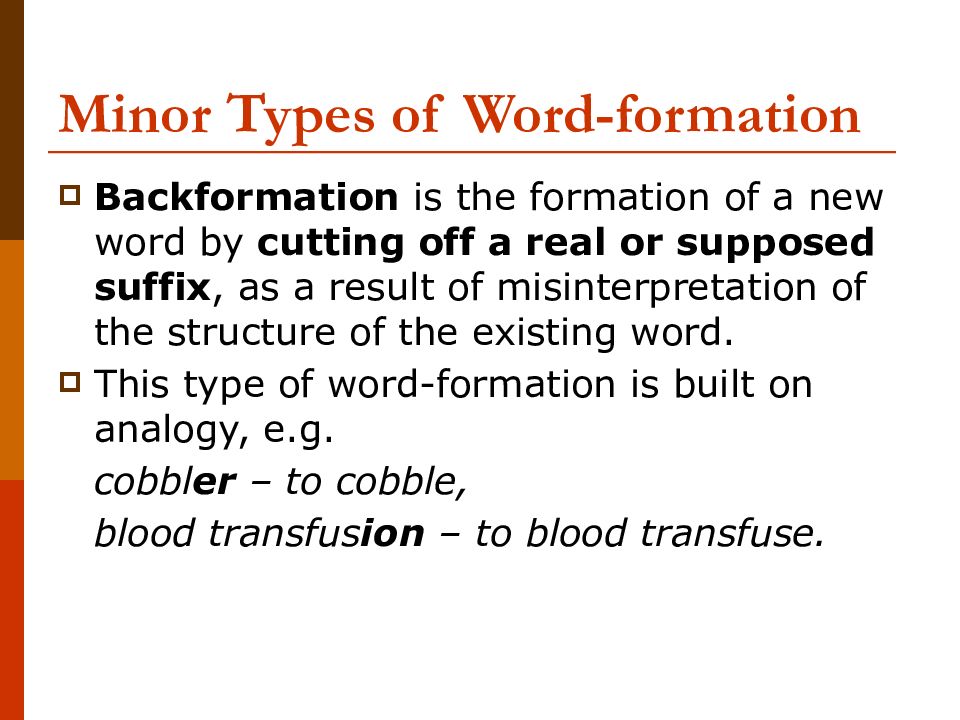Первый слайд презентации: THE WORD-FORMING SYSTEM OF ENGLISH
Sailaubay Nazerke Zhumagul Zhanerke Bogenbay Meruert
Слайд 2: THE WORD-FORMING SYSTEM OF ENGLISH
Types of Forming Words. General Issues Major Types of Word-formation Minor Types of Word-formation
Слайд 3
Word - formation is a branch of Lexicology which studies the process of building new words, derivative structures and patterns of existing words. All ways of forming new words can be classified into two big groups: major and minor types of creating new words.
Слайд 4
Two major types – word-derivation and word-composition The minor types – comprise shortening, blending, acronymy, sound imitation, sound interchange, back-formation, distinctive stress.
Слайд 5: Major Types of Word-formation
Word-formation deals with words which can be analyzed both structurally and semantically. Simple words are closely connected with word-formation: they serve as the foundation of derived and compound words. E.g., consumer, misunderstand, sugar free vs to consume, to understand, free are irrelevant to it.
Слайд 6: Major Types of Word-formation
Word-derivation: affixation and conversion. Affixation is the formation of a new word with the help of affixes ( happi ness, mis print ). Affixation → suffixation and prefixation. Suffixation is mostly to coin nouns and adjectives. Prefixation is mostly to coin verbs. Word-derivation deals with the derivational structure of words: derivational bases, derivational affixes and derivational patterns.
Слайд 7: Major Types of Word-formation
A derivational base is the part of the word which establishes connection with the lexical unit that motivates the derivative and determines its individual lexical meaning describing the difference between words in one and the same derivative set. For example, the individual lexical meaning of the words consumer, dealer, teacher which denote active doers of the action is presented by the lexical meaning of the derivational bases: consume-, deal-, teach-.
Слайд 8: Major Types of Word-formation
Derivational affixes are Immediate Constituents of derived words in all parts of speech. Derivational affixes are added to derivational bases. Affixes can be of two types: prefixes and suffixes.
Слайд 9: Major Types of Word-formation
Prefixes modify the lexical meaning but rarely transfer a word into a different part of speech: hear (v) → over hear (v), fair (adj) → un fair (adj), president (n) → ex -president (n), etc. Suffixes also modify the lexical meaning but not necessarily transfer a word into a different part of speech: king (n) → king dom (n), book (n) → book ish (adj), rapid (adj) → rapid ly (adv), etc.
Слайд 10: Major Types of Word-formation
A derivational pattern is a regular meaningful arrangement, which imposes rigid rules on the order and the nature of the derivational base and affixes that may be brought together to create a new word. Derivational patterns are also known as structural formulas. Here are some examples of derivational patterns: n + - sf → N (friend + ship), v + - sf → N (sing + er), etc.
Слайд 11: Major Types of Word-formation
Conversion is the formation of a new word by putting a stem of the already existing word into a different paradigm ( fly (noun) – fly (verb)), thus, by changing the category of a part of speech without adding any derivative elements, so that the original and the converted words become homonyms. E.g., the paradigm of the verb fly → fly, flies, flying, flew, flown, the paradigm of the noun fly → fly (sg) and flies (pl).
Слайд 12: Major Types of Word-formation
Conversion is highly-productive and widely-spread among verbs and nouns. Converted words can sound extremely colloquial, e.g. I’ll microwave the chicken for you. Conversion can be explained by the analytical character of the English language, deficit of inflections and abundance of monosyllabic and disyllabic words in different parts of speech.
Слайд 13: Minor Types of Word-formation
Minor types of modern word-formation are shortening, blending, acronymy, sound interchange, sound imitation, distinctive stress, back-formation, and reduplication.
Слайд 14: Minor Types of Word-formation
Shortening is the formation of a new word by cutting off a part of the word. Types: · aphaeresis – initial part of the word is clipped, e.g. history → story, telephone → phone; · syncope – the middle part of the word is clipped, e.g. madam → ma'am; specs → spectacles · apocope – the final part of the word is clipped, e.g. professor → prof, vampire → vamp; · both initial and final, e.g. influenza → flu, detective → tec.
Слайд 15: Minor Types of Word-formation
Polysemantic words are usually clipped in one meaning only. E.g., doctor → 1) someone who is trained to treat people who are ill; 2) someone who holds the highest level of degree given by a university. Thus, it can be clipped only in the first meaning, e.g. doc. There can be distinguished homonyms, so that one and the same sound and graphical lexical unit may represent different words, e.g., vac – vacation and vacuum, vet – veterinary surgeon and veteran.
Слайд 16: Minor Types of Word-formation
Blending is the formation of a new word which combines the features of both clipping and composition, e.g. boatel (boat + hotel), brunch (breakfast + lunch), smog (smoke + fog), modem (modulator + demodulator).
Слайд 17: Minor Types of Word-formation
Acronnymy is the formation of a new word by means of the initial letters of a word or phrase. Acronyms are commonly used for the names of institutions and organizations. No full stops are placed between the letters.
Слайд 18: Minor Types of Word-formation
Sound-interchange is the formation of a new word due to an alteration in the phonemic composition of the root of a word. Sound-interchange can be of two types: vowel-interchange, e.g. full – fill ; in some cases vowel-interchange is combined with suffixation, e.g. long – length ; consonant-interchange e.g. believe – belief.
Слайд 19: Minor Types of Word-formation
New words formed by sound imitation denote an action or a thing by more or less exact reproduction of the sound which is associated with it. Let’s compare such words from English and Russian: cock-a-dodoodle-do – ку - ка - ре - ку, bang – бах, бац ( сильный удар ).
Последний слайд презентации: THE WORD-FORMING SYSTEM OF ENGLISH: Minor Types of Word-formation
Backformation is the formation of a new word by cutting off a real or supposed suffix, as a result of misinterpretation of the structure of the existing word. This type of word-formation is built on analogy, e.g. cobbl er – to cobble, blood transfus ion – to blood transfuse.
